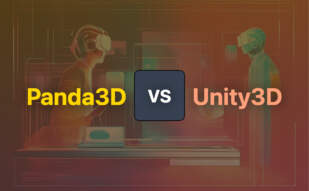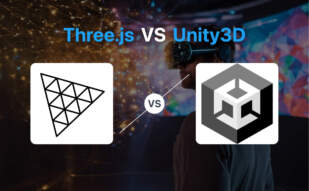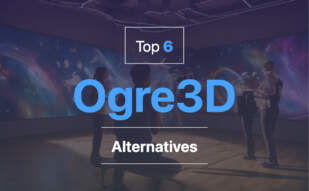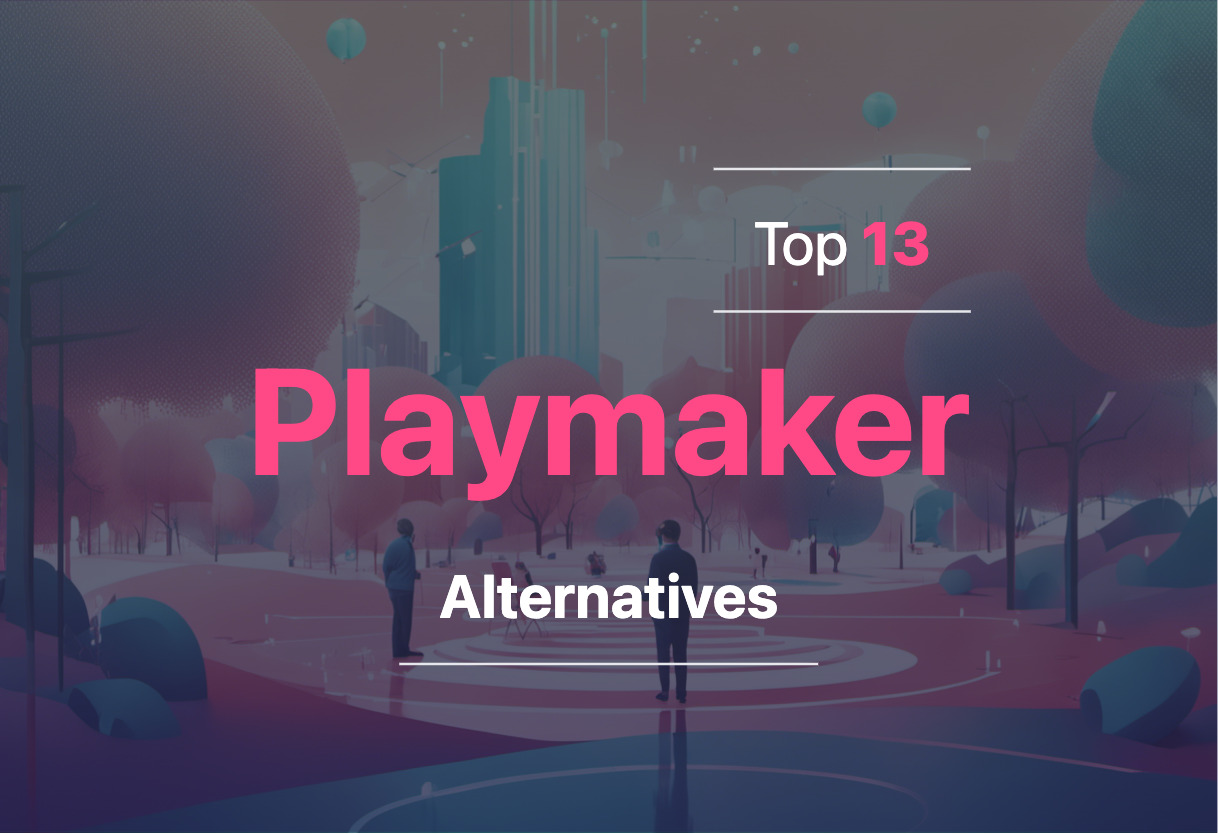
Unity3D
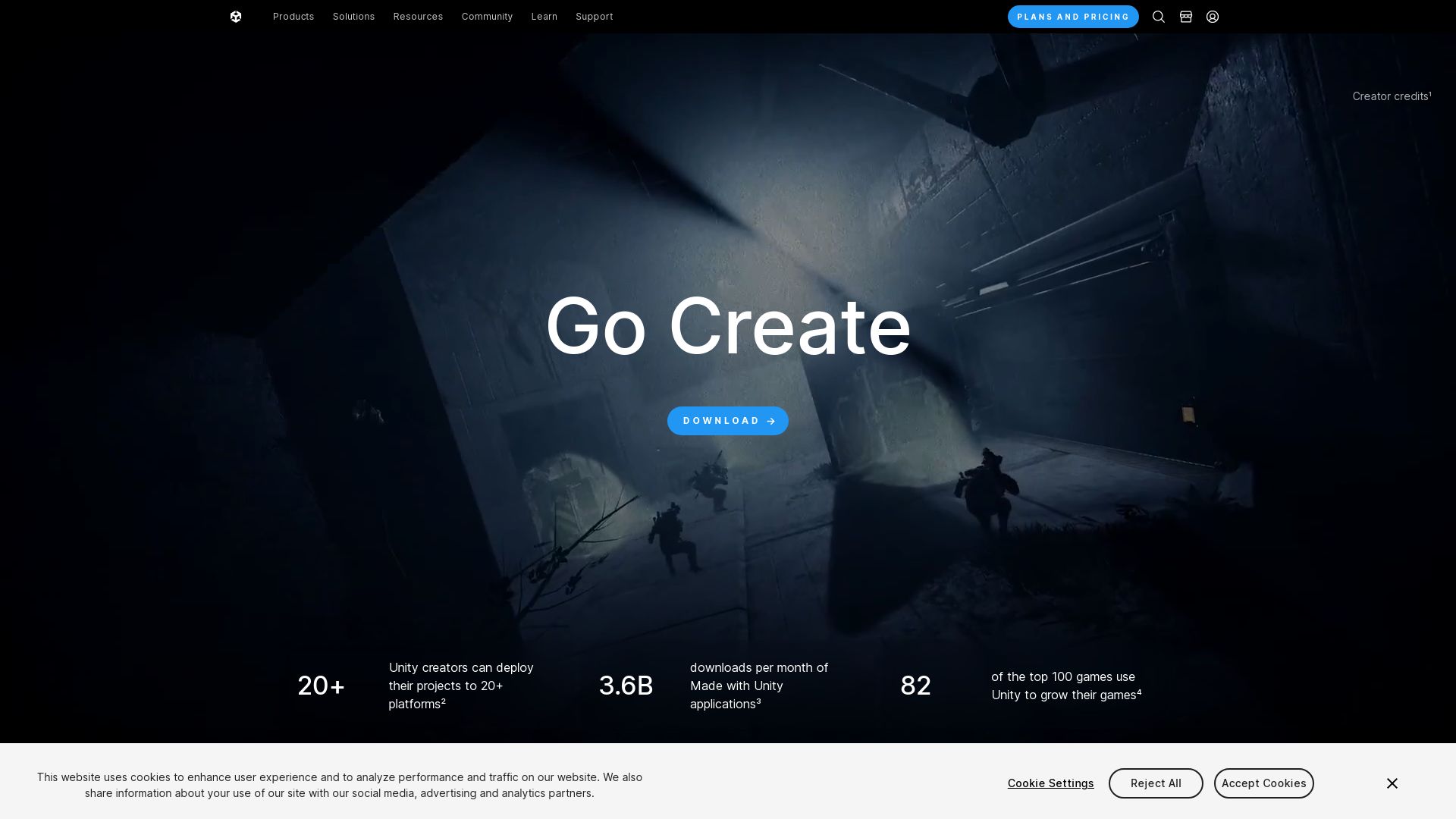
An innovation in the realm of game development is Unity3D. A product of Unity Technologies, it is a cross-platform-indie-friendly game engine with far-reaching influence extending beyond gaming to industries such as film, automotive, engineering and more. Born in 2005, Unity3D has worked in collaboration with various desktop, mobile, console, and virtual reality platforms, gaining notable popularity for iOS and Android mobile game development.
Unity3D: Top Features
- C# scripting API and JavaScript scripting language integration provide robust scripting capabilities.
- Flexible design with both 2D and 3D game development – for 2D physics Unity3D uses the Box2D engine.
- Extensive cross-platform release functionality, and API for custom scripting tools, enhancing usability.
- Promotes creativity via a vast collection of scripts, models, sceneries, materials on the Unity marketplace.
| Cross-platform support: | No need for developers to rewrite most of the codes for different platforms. |
| IDE compatibility: | Seamlessly integrates with Visual Studio, Mono Develop IDE strengthening code development. |
| Optimized Performance: | The platform, developed in C++, is optimized for best performance standards. |
Unity3D: Limitations
- Pricing policies, especially the ‘Per Install’ fee from 2024, have received backlash.
- Unity3D faces fierce competition from alternatives like Unreal, Godot.
- Political shifts and volatile pricing policies impacting user confidence.
Unity3D Pricing
Unity3D has a varied pricing structure for students, personal use, and enterprises. Eligibility parameters include financial metrics like revenue thresholds. Unity licenses, launching additional features, have variable costs, up to $1500. Specifically, the business model suits game development ventures generating revenue up to $200K.
Unity3D Use Cases
Use case 1: Indie Game Development
Unity3D, with its easy-to-use design, is a popular choice for indie game developers. The platform’s wide-ranging features and scripting capabilities enhance independent game creation.
Use case 2: Mobile Game Development
For developers eyeing the mobile game space, Unity3D serves as a powerful tool. It supports iOS and Android platforms, opening a myriad of opportunities for mobile app development.
Use case 3: Film and Automotive Industries
Unity3D is not confined solely to gaming. Industries like film and automotive have found rewarding applications of this technology, expanding Unity3D’s utility.
GameMaker
Bringing to life the visions of game developers from novices to full-timers, GameMaker is a 2D game engine with simplicity at its core, and scalability as its promise. It’s the magic behind popular games like Undertale, Forager, and Chicory: A Colorful Tale, and has been progressively developed for over 17 years.
GameMaker’s Top Features
- Easy-to-use interface suitable for beginners and professional developers.
- Scalability features that aid in creating complex, larger scale games.
- Extensive toolkit that has been influential in building games like Orbit and Hyper Light Drifter.
- Offers a Language Server for Syntax Highlighting and Intellisense support, catering to different coding languages such as JSON and XML.
- Expected to receive major updates in 2023, including a new code editor and enhanced modding capabilities.
| Integration Features | Community Support |
|---|---|
| Working with OpenAI to further integrate AI into the game-making process. | Balances engine updates between new features, basic maintenance, and user feedback. |
| Mod.io extension to incorporate user-generated content into games. | Emphasizes on community building and support for game developers. |
GameMaker Limitations
- The primary focus is on 2D game development; 3D capabilities are limited.
- Can be less versatile and intuitive compared to other game engines.
GameMaker Pricing
GameMaker offers varied pricing tiers to cater to different needs: Free for learners, Creator for game development on desktop stores, Indie for game release with multiple export options, and Enterprise for studio releases on major consoles.
GameMaker Use Cases
Use case 1: Novice Game Designers
GameMaker’s simplicity and intuitive interface make it an excellent learning tool for aspiring game developers. It provides a supportive platform for beginners to test, iterate, and release their creations.
Use case 2: Indie Game Developers
GameMaker’s robust toolkit and scalability features attract independent developers seeking to design unique and engaging 2D games. It offers flexibility to design games with varied complexity levels.
Use case 3: Commercial Game Development Studios
Commercial game development studios can benefit from GameMaker’s Enterprise tier, which provides multiple export options enabling releases on major consoles. The engine’s continuous updates and expanding capabilities support a robust development process.
RPG Maker
Arcade enthusiasts and story lovers, get ready for some nostalgia! RPG Maker, a game development engine so rooted in our gaming past, it’s almost vintage chic. Developed by ASCII, now known as Enterbrain, it was born way back in December ’92. So why is it still relevant today?
Let’s take it from the top… or rather, its top features!
RPG Maker Top Features
- No coding knowledge required: RPG Maker’s latest iteration, RPG Maker MV, is a blessing for coding newbies.
- Robust character creation options: Goes a long way to bring your wildest imagination to life.
- Cross-platform Support: Play on anything from a Sega Saturn to a PlayStation 4…and everything in between!
- Extensive Support and unique designs: From the first version released for NEC PC-9801 to the latest RPG Maker MZ, RPG Maker thrives through extensive user modifications and support.
| Feature | Explanation |
|---|---|
| Over 200 DLCs | Priced reasonably between $5 and $25, it keeps the game fresh and exciting. |
| Story-Driven Element | A strong emphasis on narratives rather than traditional game features. |
| Community Support | Extensive user modifications and consistent update sharing, keeping the engine dynamic. |
RPG Maker Downsides
Now, let’s not forget everything has limitations, even a charmer like RPG Maker, the notable few are:
- Designs are subject to the engine’s limitations. Meaning? You might need a skilled developer for an innovative game.
- Despite its simplicity, the platform was in the middle of few controversies involving some of its user-generated games. But hey, a little controversy makes for a good conversation starter, right?
- It may not be the best choice for games focusing on features other than the story-driven elements.
RPG Maker Pricing
Though base packages are often free, additional downloadable content (DLCs) for RPG Maker MV range between $5 and $25. Here’s hoping your piggy bank is ready!
RPG Maker Use Cases
Use case 1
RPG Maker is beloved by beginner developers looking to dip their toes in game development. Its user-friendly, no-coding-needed approach fosters creativity without the intimidation of complex code.
Use case 2
For indie game designer, RPG Maker boasts an array of unique design templates, mostly free plugins, and abundant DLCs, transforming vision to reality.
Use case 3
If you’re a story-driven game aficionado, RPG Maker encourages a focus on narratives rather than traditional features, making it the perfect tool to craft your immersive epic tale.
jMonkeyEngine
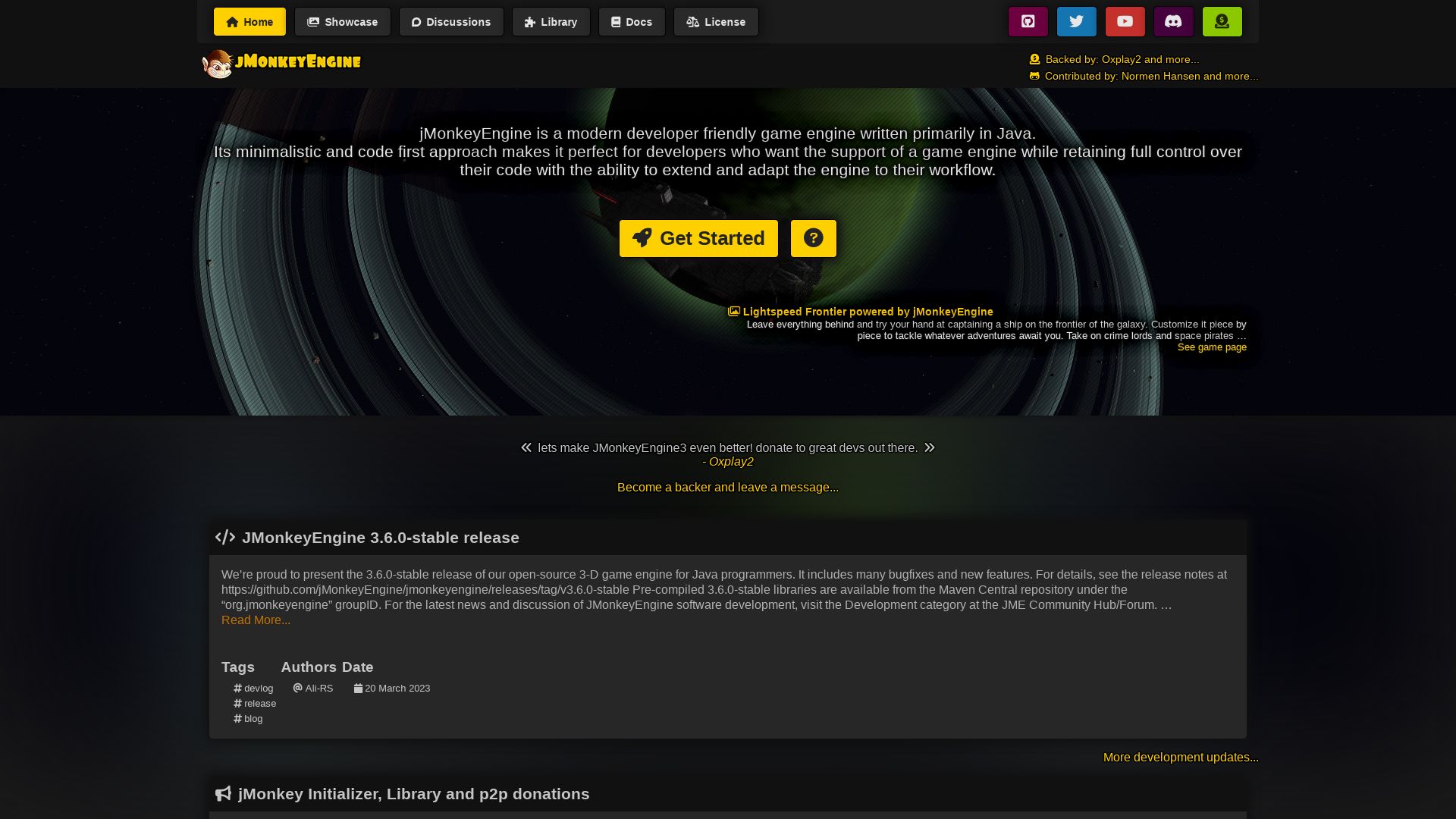
An open-source, Java-based game engine that operates on a code-first approach, jMonkeyEngine focuses primarily on developers. The engine is noted for the development of RPG game, Mythruna and can be utilised across Android, Linux, iOS, and Mac. The recent 3.6.0-stable update, made available on 20 March 2023 includes several bugfixes and new features, ensuring a streamlined user experience.
jMonkeyEngine Top Features
- Multi-platform: PC, Linux, iOS, Android and Mac.
- 3D audio support: With OpenAL, jmePhonon for immersive sounds.
- Terrain libraries: For creating an incredible range of terrains.
- Multiple GUI options: Including Lemur, Nifty GUI, IGUI.
- Advanced particle: Abilities with multiple options.
- Post-processing capabilities: Includes filters for Bloom FXAA, Light Scattering etc.
| jMonkeyEngine Initializer: A handy web tool for project creation. | Free: Open-source, under a permissive BSD 3-Clause license. |
| Good Documentation: Comprehensive official and user-generated content available. | Active Community: Supported by an active forum of developers. |
| Multiple Networking Options: Including Spidermonkey, SimEthereal, Monkey Netty. | Physics: Supports multiple solutions including jBullet, Minie. |
jMonkeyEngine Limitations
- Lower-level game development tool.
- Despite its adaptability and learning curve, it has some limitations compared to others.
jMonkeyEngine Pricing
Being open-source, jMonkeyEngine is accessible for free under a permissive BSD 3-Clause license.
jMonkeyEngine Use Cases
Use case 1
jMonkeyEngine is instrumental in game-education programs. Its ease of use makes it perfect for young and adult learners alike.
Use case 2
As a game development engine, jMonkeyEngine has been chosen for multiple commercial game projects, showcasing its adaptability and robust performance.
Use case 3
RPG game, Mythruna, is currently in development using jMonkeyEngine, illustrating the engine’s potential for creating complex, immersive experiences.
O3DE
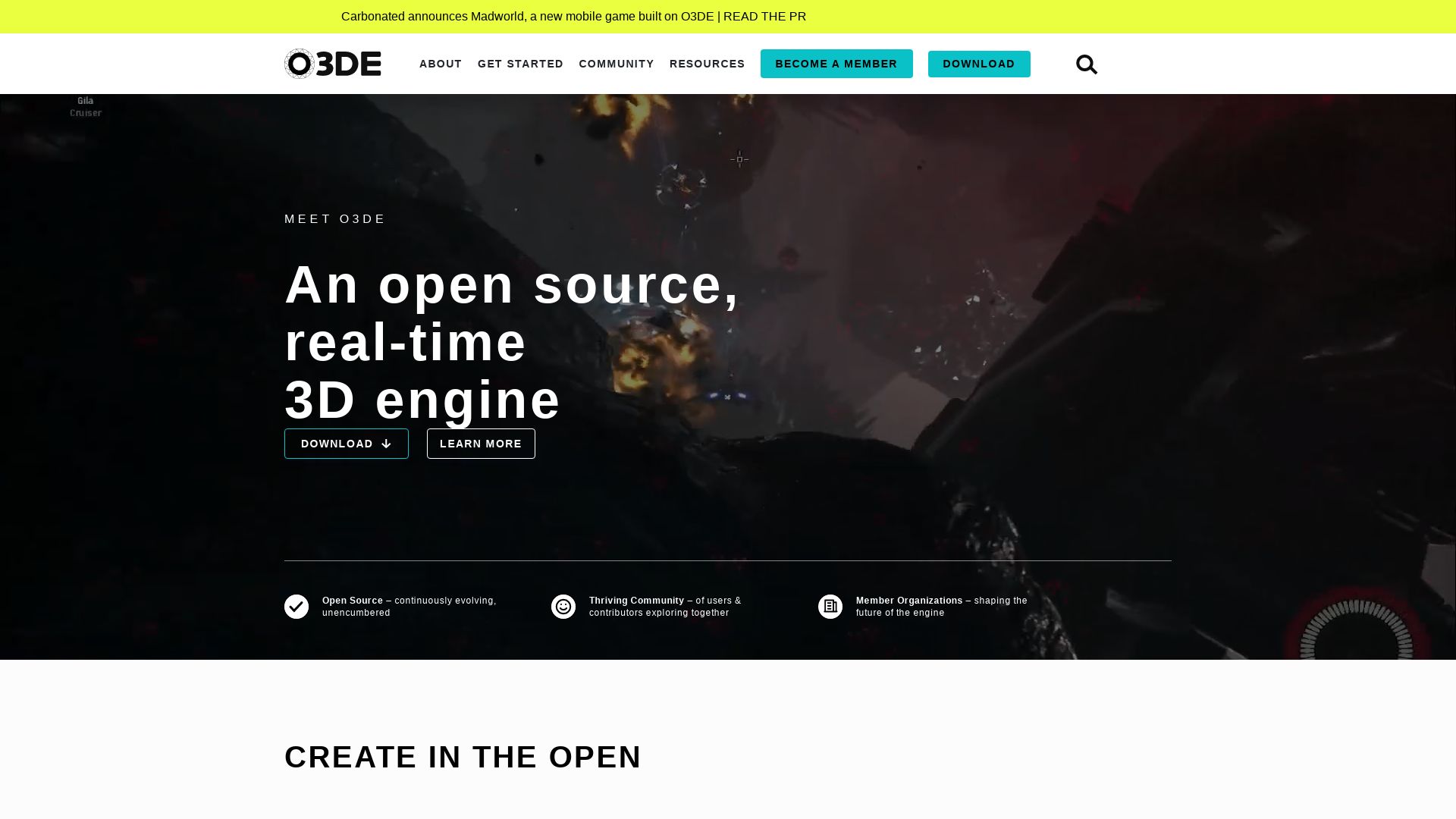
The O3DE, or Open 3D Engine, is an open-source, real-time 3D engine refined for construction of high-performance, interactive experiences. Developed by the Open 3D Foundation and in use since its initial release on July 6, 2021, it empowers developers to simulate physics, animate, and create intricate cinematics through programming languages including C++, Lua, and Python.
O3DE Top Features
- Modular engine and components: Composed of Gems, which are libraries with standard interfaces, the O3DE furnishes flexibility in project development.
- Support for Precompiled Gems: O3DE Gems can be added or removed without requiring a recompilation of the engine code.
- Usage of CMake: O3DE employs CMake to generate build files and automate code, fostering efficiency.
- Data-driven Asset Workflows: With tools to manage assets, O3DE enables dynamic developments.
| Feature | Description |
|---|---|
| Physically Based Renderer | Facilitates high visual fidelity in models |
| Script Canvas or Lua | Used for runtime logic, these scripting integrations fortify interaction capabilities. |
| Python Scripting Support | Further unravels customization scope for developers. |
O3DE Limitations
- High System Requirements: As O3DE necessitates a high-end system (Windows 10 1809 or higher, or Ubuntu 20.04 or higher), it might limit its usage among users with low-end systems.
- Competition: The presence of robust competitors like Unreal Engine, Godot, and Unity could muddy its market penetration.
- Quality expression: With middling reviews received for the Lumberyard-based New World game, there could be concerns about the quality of experiences crafted via O3DE.
O3DE Pricing
The Open 3D Engine is available royalty-free and open source, granting developers freedom in both usage and potential modifications.
O3DE Use Cases
Use case 1: Constructing Assets
O3DE’s data-driven asset workflow provides developers with vast scope to construct assets with ease. Its modular engine and flexible components aid in creating diverse and complex assets for game and simulation development.
Use case 2: Game Simulation
The engine’s high performance, real-time 3D capabilities, and physics simulation arrive in force for complex games and simulation development, all backed by Python and Lua scripting support.
Use case 3: Industrial Simulation
With respected partners like Red Hat and Huawei noting O3DE’s merits, one can consider its use in industrial simulation, where Python scripting support can enable automation and interaction within simulated environments.
Godot
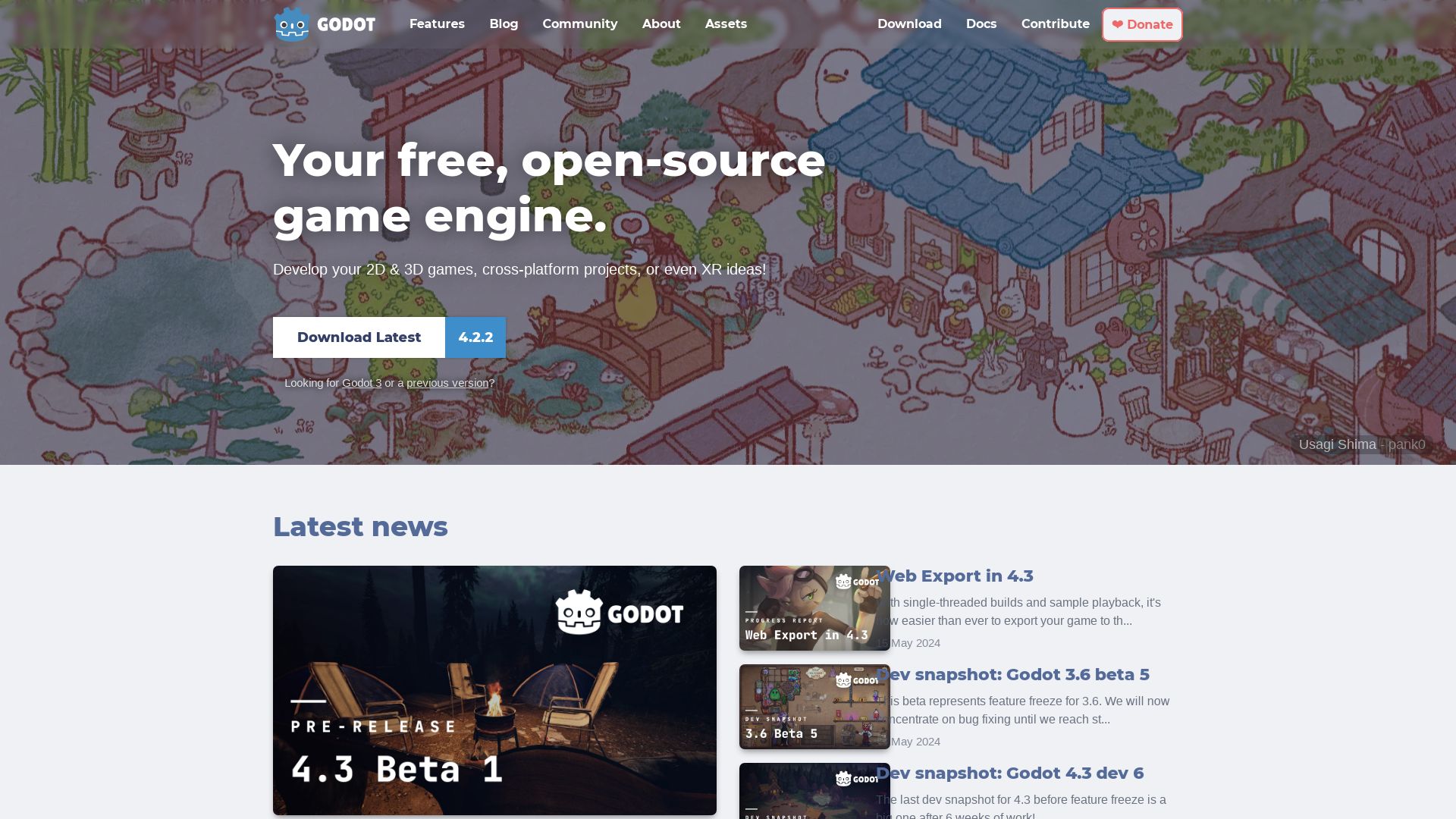
An open-source game development engine, Godot bestows its users with a wide array of flexible and reusable game creation tools. Favored by developers worldwide, Godot operates its unique, scene-driven design across multiple platforms with no hidden fees or contracts.
Godot Top Features
- Intuitive scene-driven design: Godot breaks applications into reusable scenes comprising one or more nodes.
- Powerful Scripting Languages: Godot supports an in-house GDScript, C++, and C#, with community support for Rust, Nim, Haskell, Clojure, Swift, and D.
- Device Compatibility: Godot’s 3D engine is designed to support both high and low-end devices, offering specialized 2D workflows for games and apps.
- Continuous Improvement: Regular updates and improvements to enhance user experience.
| Feature | Details |
|---|---|
| Blender File Import | Godot allows direct import of Blender files, simplifying the game design process. |
| Audio System | Godot includes an Audio Bus/Layout system with real-time effects implementation. |
| Built-in Tools | Equipped with editing and scripting tools plus profilers and debugging tools for streamlined game logic. |
Godot Downsides
- Limited support for complex 3D game development.
- .NET support is available only for desktop platforms in Godot 4.
Godot Pricing
Godot is completely free under the MIT license, eliminating any concerns over licensing fees or contracts. Being open-source, its codebase is openly modifiable.
Godot Use Cases
Use case 1
For developers aiming to create 2D games or apps, Godot’s specialized 2D workflow is an invaluable tool.
Use case 2
For beginners in game development, Godot’s intuitive scene-driven design simplifies the learning curve.
Use case 3
For teams working collaboratively, Godot’s open source storage solution facilitates efficient team collaboration.
Construct 3

Developed by Scirra Ltd, Construct 3 is a robust HTML5-based 2D game development engine, designed for both beginners and professional developers.
Construct 3 Top Features
- Visual Programming: Utilizes ‘event sheets’ – logic-based actions triggered by specific conditions leading to swift game creation.
- Flexible Accessibility: Can be used on any device and offers support for offline use.
- In-Built Pixel Editor: For game graphics creation.
- JavaScript Scripting: Provides greater control and customizability for advanced users.
| Feature | Description |
|---|---|
| Strong Behavior Support | Includes solid, platformer, tile movement, and anchor among others. |
| Online Interface | Facilitates pseudo 3D visual and 2D video games creation. |
| Compliance | Meets data privacy regulations including COPPA, CCPA, and GDPR. |
Construct 3 Limitations
- Challenges with creating large-sized games.
- Not suitable for 3D game development.
- Lacks native exporters leading to limited application support like Apple TV.
Construct 3 Pricing
Construct 3 offers a free license as well as a paid subscription with more features, starting at $99/year for the personal plan.
Construct 3 Use Cases
Use Case 1: Indie Developers
Ideal for the creation of small to mid-sized 2D games, especially for indie developers due to its ease of use and swift development process.
Use Case 2: Educators
Favored for coding curriculum in over 400 schools across 48 US states because of its simple programming process and offline download feature.
Use Case 3: Advertisement
Used in creating HTML5-based interactive advertisements while being compatible across all major browsers.
Panda3D

In the intriguing realm of gaming development engines, Panda3D, a versatile platform introduced by Disney Interactive, thrives by synergizing the power of Python and C++. It stands tall, an astrograph of innovation originating from 3D theme park attractions like “Aladdin’s Magic Carpet”. Now it is embraced by large commercial games, university courses, and open-source projects.
Panda3D Top Features
- 3D Rendering: Highly-optimized for 3D visualization, equipped with custom shaders and modern per-pixel lighting techniques.
- Python and C++ Support: While written in C++, Panda3D fosters Python for scripting, making your language preferences no barrier.
- Scene Graph Engine: Immerse in the Cartesian space, one can easily insert and manage 3D models in the game.
- Multi-Platform: A deity of flexibility, it operates seamlessly on Microsoft Windows, Linux, macOS, Free BSD.
- Free and Open Source: With a BSD license, Panda3D projects no cost while inviting the community to contribute.
| Feature | Description |
|---|---|
| Audio Systems | Enrich your game’s acoustic palette with FMOD, OpenAI, or Miles Sound System. |
| Physics and Collision Detection | Design realistic environment with its inherent physics engine and collision detection system. |
| Networking and AI | Create interconnected gaming worlds and intelligent non-player characters. |
Panda3D Downsides
- Lack of Beginner Support: Panda3D is no mere toy, it demands a basic understanding of Python, APIs, and the love of riddles.
- Third-Party Dependencies: FMOD, Nvidia Cg, DirectX, and MFC, among others, are needed to unlock its full potential.
Panda3D Pricing
Step into the world of Panda3D without a toll, as it cordially stands as a free and open source gem, continually polished by contributions across the globe.
Panda3D Use Cases
Use case 1 – Commercial Game Developers
Ride on the power of Panda3D to create enchanting tales, as done in games like Toontown Online and Pirates of the Caribbean Online.
Use case 2 – Open Source Projects
Incorporate Panda3D in your open-source odyssey, breaching the pinnacles of gaming technology.
Use case 3 – Educational Institutions
Imbue coding classes with a sense of magic and invite students to craft awe-inspiring universes with Panda3D.
Solar2D

If you’re seeking a robust, versatile, and free yet powerful game development platform, then look no further than Solar2D. Originally known as Corona SDK, it has an impressive legacy of over a decade of active development and supports multi-platform mobile app development.
Solar2D Top Features
- Allows development for a multitude of platforms including mobile, desktop, and TV devices (including iOS, Android, macOS, Windows, and more) using a single code base.
- Real-time testing of code modifications and asset changes with an instant-update Simulator.
- Offers Solar2D Native feature that makes it possible to call to native (C/C++/Obj-C/Java) libraries/APIs.
- Provides a wealth of plugins for in-app advertising, analytics, media through the Solar2D Marketplace and free directory.
- Scripting is performed in Lua, a leading language in Game Development.
| Key Attribute | Description |
|---|---|
| Community | A vibrant and supportive community of thousands of developers. |
| Licensing | Open-source under an MIT license, with no hidden fees, royalties, or unnecessary tracking. |
| Extended Support Features | Offers additional resources such as Developer Guides and an API Reference site. |
Solar2D Limitations
Despite a plethora of features, potential obstacles with Solar2D include:
- Lack of 3D capabilities due to its focus on 2D mobile and desktop applications.
- The learning curve associated with Lua-based development for beginners.
Solar2D Pricing
The best part? Solar2D is absolutely free! Its open-source model means developers will not encounter hidden charges or royalties, and you get to keep the rights to your source code.
Solar2D Use Cases
Use Case 1
For indie game developers, Solar2D offers a cost-effective solution due to its free and open-source model. It provides rapid development opportunities with over 1000 APIs, making it an ideal choice for developers on a budget.
Use Case 2
Are you a developer looking for cross-platform support? Then Solar2D could potentially be your tool of choice. Its single code base allows for development across diverse operating systems, making it highly versatile and efficient.
Use Case 3
For educators and learners in game development, Solar2D provides a productive environment. It’s based on Lua, a language prominently used in game development and education – making it a great resource for teaching and learning the fundamentals of game programming.
Heaps

Having garnered attention as the power behind high-profile games such as Rushberry Mercs, Voidrun, Nuclear Blaze, and Evoland, Heaps is a mature, cross-platform graphics engine leveraged for creating advanced performative games. Pioneered by Nicolas Cannasse, a prime figure in Haxe programming language and the founder of Shiro Gaming, Heaps exudes strength in its community association, particularly in indie game development.
Heaps Top Features
- High-performance, maturing engine developed with Haxe programming language
- Supports both 2D and 3D capabilities
- Workhorse behind complex game systems and deep storylines
- Integrates different game genres including Arcade, Role Playing, Real-time Strategy, etc.
- Known for its performance optimization, stability, and power, as shown in games like Dead Cells and Northgard
| Creator | Nicolas Cannasse |
| Popular Games | Dead Cells, Northgard |
| Game Genres Supported | Arcade, Role Playing, Real-time Strategy, Turn-Based Strategy, etc. |
Heaps Limitations
- More of a library than a full-featured game engine unlike Godot or Unity
- Community transition from Flash to Haxe may be challenging for some
Heaps Use Cases
Use case 1: Indie Game Developers
Heaps shines bright in the indie game development realm due to its potential for creating intriguing storylines and complex game systems.
Use case 2: Creators transitioning from Flash
For developers seeking a platform-independent alternative following Flash’s decline, Heaps, with its Haxe foundation, presents a promising solution, particularly with HaxeFlixel being a popular recommendation.
Use case 3: High-Performance Game Development
Developers and creators looking for performance optimization, stability, and power in their games could harness Heaps, as proven by its successful integration in titles like Dead Cells and Northgard.
Blender

For anyone seeking a comprehensive 3D computer graphics suite, Blender is certainly worthy of your attention. Born from the genius of Dutch animation studio NeoGeo and the main developer Ton Roosendaal, Blender is a free and open-source tool that has powered countless animated films, visual effects, and interactive 3D applications since its inception on January 2, 1994.
Top Features of Blender
- 3D modeling and texturing: Sculpt, UV map, and create 3D models with ease.
- Animation and rigging: Bring your creations to life with powerful animation features.
- Motion graphics and video editing: Perfect for designing stunning visuals and enhancing video production.
- Fluid, smoke, and particle simulation: Increase the realism and dynamism of your projects.
| Features | Benefit |
|---|---|
| Digital Drawing | Designs can be crafted right from scratch. |
| Raster Graphics Editing | Edits are precise and tailored to exact needs. |
| Wide Format Support | Can work with a range of 3D file formats including Alembic, 3DS, FBX, and more. |
Blender Limitations
- The Blender Game Engine has been deprecated in the 2.8 release.
- Blender’s internal rendering solution was removed in the 2.80 release, favoring the Eevee renderer.
Blender Pricing
One of the critical advantages Blender offers is its open-source nature. It is absolutely free to use, embodying its community-focused ethos.
Blender Use Cases
Use case 1 – Animated movies
Blender’s range of modeling and animation tools make it ideal for crafting engaging and original animated films.
Use case 2 – Visual Effects
For visual effects artists, Blender’s robust simulation capabilities can create realistic and impactful scenes.
Use case 3 – Virtual Reality
Blender is also a potent tool in the realm of VR, offering interactive 3D applications for a gripping, immersive experience.
GameSalad
A game creation engine revolutionizing the digital landscape, GameSalad. No coding required! Create games using drag-and-drop action for iPhone, iPad, Android, and HTML5. This isn’t just game development; this sparks creative thinking, fosters problem-solving, and empowers logic-based learning.
GameSalad Key Features
- In-App Previewer: Lets you test games directly, ensuring what you create is what you get.
- Extensive Behavior Libraries: Easily imbue your game characters with complex actions and reactions.
- Multi-Platform Publishing: Reach your audience wherever they are with support for Android, iOS, Windows, Amazon Marketplace.
- GameSalad Creator: Explore CS principles in a fun and engaging way while crafting unique game experiences.
| Feature | Description |
|---|---|
| Drag-and-Drop Coding | Simple, intuitive game creation without requiring any coding knowledge. |
| Scene Editor & Integrated Physics | Deliver realistic environments with physical interactions that players can feel. |
| Web Publishing System | Publish anywhere with the power of HTML5. |
GameSalad Limitations
- Introduction of the “Free-to-Make” model in 2010 was discarded in 2015. The service is no longer free.
- In October-November 2012, they laid off half of their staff, affecting support and updates.
GameSalad Use Cases
Use case 1 – Education
Used in over 223 schools, GameSalad is a potent tool for teaching computer science concepts – making learning interactive and fun.
Use case 2 – Indie Game Developers
The power to create and publish games for a multitude of platforms without any coding knowledge makes GameSalad a dream come true for many indie game developers.
Use case 3 – STEAM Learning
With Connally High School, Texas and James B. Conant High School, Illinois already harnessing GameSalad for game design education, fill your STEAM learning endeavors with interactive infusions.
Stride
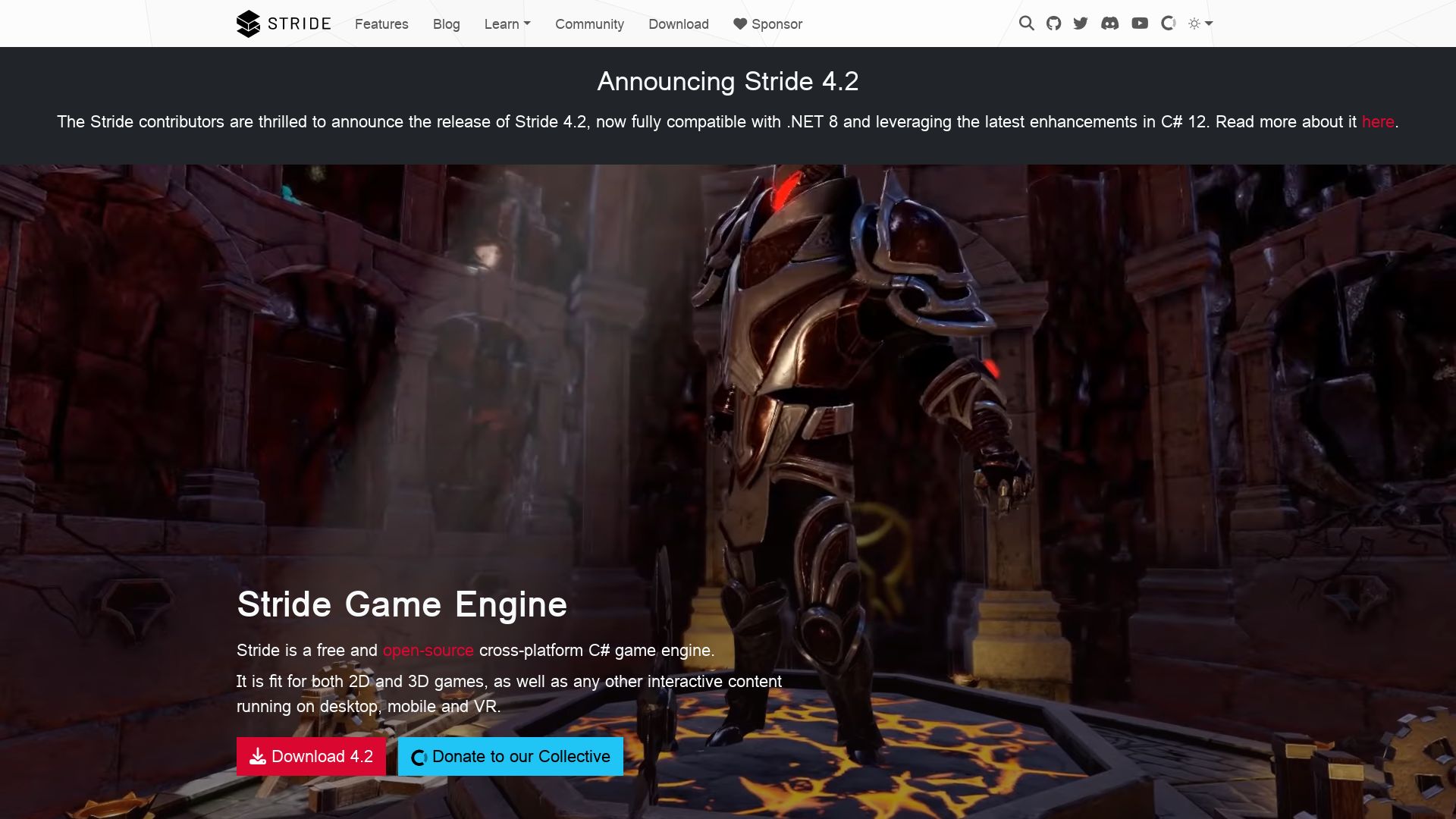
Stride, formerly Xenko, stands as a free, open-source, 2D and 3D cross-platform game engine. Developed by Silicon Studio, the Stride game engine is a versatile powerhouse for creating interactive content for PC, mobile devices, and even virtual reality.
Stride Top Features
- C# suite tools for extensive customization and control
- Customizable shader system tailored to bring your designs to life
- Integrated environment for asset import, scene creation, and arrangement using an Entity component system in the Game Studio
- Photorealistic postprocess effects for captivating visual experiences
| Asset Editors | Cross-Platform Runtime Support |
|---|---|
| PBR layered material editor, particle editor, sprite editor, scripting editor | iOS, Android, Windows UWP, Linux, PlayStation 4 |
| Includes a UI engine for interface design | Also serves as 3D rendering engine for vvvv gamma |
Stride Limitations
- Requires familiarity with C# for sophisticated customization
- Community-supported model since 2018 which may impact real-time support
Stride Pricing
Given that Stride is open-source, it’s free for developers who wish to venture into the dimension of game development.
Stride Use Cases
Use Case 1: PC Game Developers
With Stride’s 3D capabilities, PC game developers can design captivating arenas and narrative worlds ready to enthrall players.
Use Case 2: Mobile Game Developers
Its cross-platform nature makes Stride an excellent choice for mobile game developers seeking to create interactive, visually appealing mobile games.
Use Case 3: VR Game Creators
Stride delivers in creating immersive and interactive virtual reality experiences that blur the boundary between the digital and physical worlds.
Logan Bellbrook
Content writer @ Aircada with a knack for nature & AR/VR/XR. Blogging the intersection of tech & terrain.



